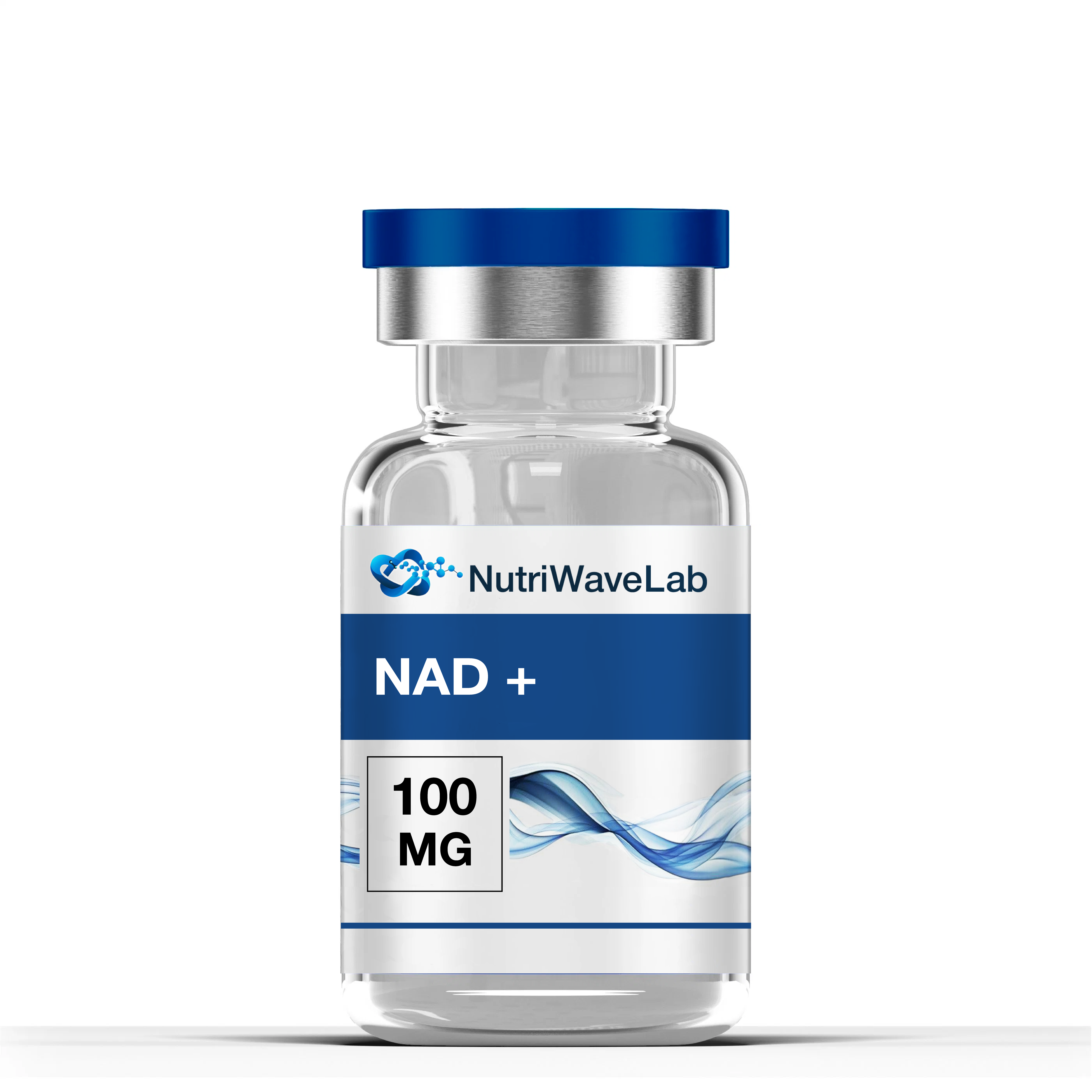NAD + 100mg
$0.00
- when buying 5 units of goods 5% discount
- when buying 10 units of goods 8% discount
2 in stock
NAD⁺ (Nicotinamide Adenine Dinucleotide)
Chemical Structure
-
Compound Type: Cofactor, nucleotide redox molecule
-
Chemical Formula: C₂₁H₂₇N₇O₁₄P₂
-
Molecular Weight: 663.43 g/mol
-
CAS Number: 53-84-9
-
PubChem CID: 5893
-
Chemical Class: Dinucleotide composed of adenine and nicotinamide joined by a pyrophosphate bridge
-
Synonyms: β-Nicotinamide adenine dinucleotide, β-NAD⁺, Diphosphopyridine nucleotide, NAD, NADH (reduced form)
Overview
NAD⁺ (Nicotinamide Adenine Dinucleotide) is one of the most fundamental molecules in cellular metabolism.
It participates in over 400 biochemical reactions, acting as a universal redox cofactor essential for energy production, DNA repair, and signaling processes associated with longevity.
In simple terms, NAD⁺ is the metabolic “currency” of the cell — the molecule that keeps mitochondria alive, neurons firing, and DNA repair systems functioning.
As NAD⁺ levels decline with age, mitochondrial efficiency drops, oxidative stress rises, and cognitive performance often decreases — leading to the familiar symptoms of “brain fog”, fatigue, and slow recovery.
Biochemical Function
-
⚡ Mitochondrial Energy & ATP Production
NAD⁺ serves as the primary electron carrier in the mitochondrial respiratory chain.
It drives the Krebs cycle and oxidative phosphorylation, determining how efficiently cells generate ATP — the universal energy molecule.
Low NAD⁺ impairs mitochondrial respiration and increases reactive oxygen species (ROS), contributing to cellular fatigue. -
🧬 DNA Repair & Genomic Protection
NAD⁺ is the substrate for PARP enzymes, which repair damaged DNA caused by oxidative stress, radiation, or inflammation.
Adequate NAD⁺ levels enhance DNA integrity and cellular resilience. -
⏳ Sirtuin Activation (SIRT1–SIRT7)
These NAD⁺-dependent enzymes regulate gene expression, stress resistance, and mitochondrial biogenesis.
Higher intracellular NAD⁺ activates SIRT1, promoting metabolic flexibility, cell survival, and potential epigenetic “rejuvenation.” -
🔁 Metabolic Regulation via AMPK
NAD⁺ interacts with AMPK, the cellular energy sensor that governs glucose and lipid metabolism, autophagy, and energy homeostasis.
Together, these pathways coordinate the cell’s adaptive response to fasting, exercise, and stress.
Research Areas of Interest
The following applications are based on preclinical and ongoing research related to NAD⁺ metabolism.
-
🧠 Cognitive Function & Brain Fog
Supports neuronal energy metabolism, enhances mitochondrial respiration, and helps restore focus and clarity during fatigue and stress. -
💪 Mitochondrial Dysfunction & Fatigue
Studied for its potential to improve cellular respiration and endurance in models of chronic fatigue, post-viral recovery (Long COVID), and metabolic burnout. -
❤️ Cardiovascular Health
Involved in endothelial repair, nitric oxide regulation, and oxidative stress reduction in vascular tissues. -
🧬 Anti-Aging & Longevity Research
NAD⁺ fuels sirtuins and PARPs, supporting DNA repair, telomere stability, and mitochondrial biogenesis — key hallmarks of cellular longevity. -
🔬 Metabolic Syndrome & Insulin Sensitivity
Linked to improved glucose uptake, lipid metabolism, and reduced inflammatory cytokines in metabolic studies. -
🩸 Inflammation & Immune Regulation
Modulates PARP and NF-κB signaling, reducing chronic inflammation and supporting immune balance. -
🧖♀️ Cellular Regeneration & Skin Health
Promotes collagen synthesis, antioxidant defense, and epidermal repair — restoring cellular vitality and elasticity.
Mechanistic Highlights
-
Activates SIRT1 / SIRT3 / SIRT6 — enzymes connected with cellular repair and longevity.
-
Increases PGC-1α expression — the master regulator of mitochondrial biogenesis.
-
Reduces inflammatory mediators (IL-6, TNF-α).
-
Restores the NAD⁺/NADH ratio and enhances ATP synthesis.
-
Supports telomere maintenance and DNA stability.
Summary
NAD⁺ is a cornerstone molecule in the network linking energy metabolism, genomic stability, inflammation control, and longevity.
In research models, it is studied for its ability to:
-
restore mitochondrial function,
-
reduce oxidative stress,
-
enhance cognitive and physical performance,
-
and promote cellular regeneration through sirtuin and AMPK activation.
In short, NAD⁺ fuels life at the molecular level — bridging the gap between metabolism, recovery, and healthy aging.
Product Use: THIS PRODUCT IS STRICTLY FOR
SCIENTIFIC RESEARCH PURPOSES ONLY. It should only be used in laboratory
settings. All product information on this website is provided solely for
educational purposes. The law strictly prohibits introducing this product into
the body of humans or animals. Only licensed professionals should handle this
product. This product is not a drug, food, or cosmetic and should not be
improperly classified or used as such.



Reviews
Clear filtersThere are no reviews yet.